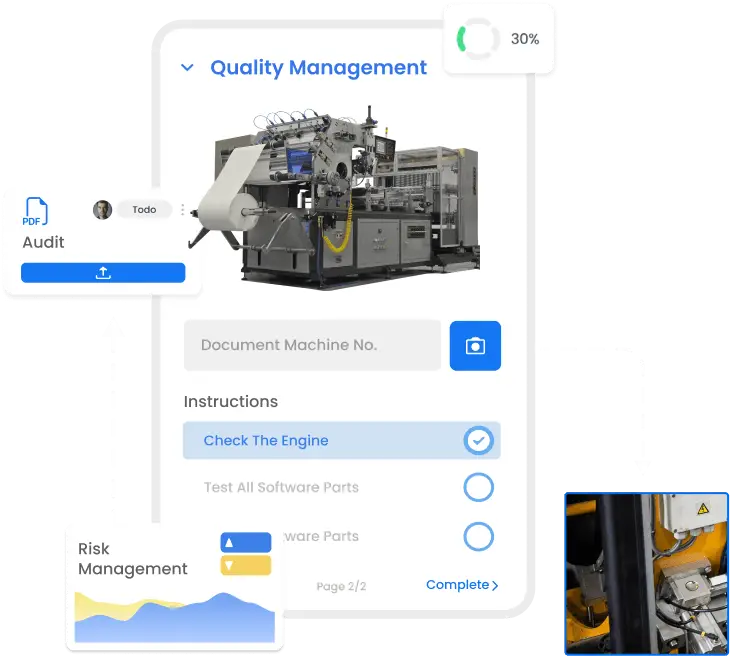Summary: Quality control is vital, for the success of any business ensuring that operations, goods, and services consistently meet or surpass customer needs. Many companies adopt a quality control system (QMS) following the ISO 9001 standard to achieve this goal. A key aspect of a QMS is the management review meeting, which plays a role in assessing the performance of the system and promoting enhancements. According to ISO 9001 guidelines senior management must periodically review the quality management system to confirm its appropriateness and effectiveness.
During this evaluation process, the adequacy of the quality management system is examined for potential revisions to quality policies. Opportunities for improvement are assessed. Management review meetings have been conducted to evaluate how well the quality management system operates, with outcomes from these meetings being a part of quality documentation. The formal management review process evaluates how well the QMS performs and lies at the heart of ISO 9001 standards. It aids in refining quality procedures ensuring adherence to regulations and enhancing product excellence – all contributing factors to business triumph.
Understanding Quality Management
What Does Quality Management Entail?
Quality management refers to an organization’s approach to ensuring that its products, services, and processes meet or exceed customer expectations. It involves the implementation of processes, procedures, and policies for enhancement, customer satisfaction, and overall organizational performance. This encompasses quality assurance, quality control, management evaluations, adherence to ISO standards, and the incorporation of ISO requirements for conformity.
Conducting management reviews led by executives is crucial for assessing the effectiveness of the company’s quality management system and pinpointing areas for improvement. These assessments are documented in meeting minutes from the management review sessions to boost performance and ensure compliance with quality standards.
ISO 9001 and Quality Management Systems
ISO 9001 is an acknowledged standard, for quality management systems that offer a structure for organizations to establish, implement, uphold, and enhance their QMS continually. Obtaining ISO 9001 certification signifies an organization’s dedication to quality and its capacity to consistently deliver products and services that meet customer expectations as regulatory requirements.
The Importance of Management Assessments
An Overview of Management Evaluation
A management assessment is a methodical examination of an organization’s quality management framework. It entails evaluating the effectiveness of the system pinpointing areas needing improvement and devising strategies to foster progress. These evaluations are typically carried out at scheduled intervals. Involve the leadership of the organization.
The Objectives of Management Assessments
Management assessments play roles within an organization. They offer executives a chance to gauge how well the quality management system is functioning review its performance, against quality goals, identify areas where standards are not met, and make informed choices to enhance operations. The outcomes of these assessments shape planning and resource allocation to boost effectiveness.
Executing a Productive Management Assessment
Establishing the Process for Management Evaluations
To conduct a management assessment it is crucial to create a defined and documented procedure. This procedure should specify the evaluation frequency of participants involved, their responsibilities, and the extent of the assessment. It should also include criteria for assessing the performance of the quality management system and methods for gathering data and information.
Information Gathering; Collecting Pertinent Data for Reviews
Management assessments are pivotal, for making informed decisions.
These evaluations depend on sources, like customer satisfaction, operational efficiency, adherence to product and service standards, audit findings, corrective measures, and preventive measures. Organizations can efficiently collect this information through surveys, feedback from customers, audits, and data analysis. It is essential that the data is precisely current and reflects the organization’s performance accurately.
Within the framework of ISO 9001, the management review process (clause 9.3) holds importance as it mandates senior management to regularly assess the company’s Quality Management System (QMS). This assessment involves reviewing outcomes from management reviews of the QMS procedures, the quality manual, and other pertinent documents.
Outputs of Review; Driving Action and Enhancing Performance
The results of a management review play a role in instigating action and enhancing performance within the organization. These outcomes might encompass decisions and initiatives related to;
- Establishing or revising quality objectives
- Allocating resources for enhancement projects
- Identifying and rectifying instances of nonconformity and risks
- Assessing the effectiveness of preventive actions
- Amending quality policies and objectives
- Directing enhancements in processes for optimization
Ensuring Compliance, with ISO 9001
Requirements, for Compliance with ISO 9001 Regarding Management Reviews
According to ISO 9001, management reviews are a part of the quality management system. These reviews involve;
- Conducting scheduled management reviews
- Evaluating the organization's quality management system
- Assessing the suitability, sufficiency, and effectiveness of the system
- Identifying opportunities for enhancement and the necessity for system changes
- Ensuring that inputs to the review are pertinent and trustworthy
- Recording the outcomes of the review
Frequency of Reviews
ISO 9001 does not specify a frequency for management reviews; it varies based on an organization’s context, size, and complexity. Nevertheless, it is advisable to conduct reviews annually. Organizations can opt to increase review frequency based on their requirements and risks associated with their operations.
The Role of Senior Management
Senior management plays a role, in conducting management reviews. They are tasked with establishing the review process setting the agenda and ensuring stakeholders’ involvement. Senior management should actively participate in reviews analyze outcomes and make informed decisions to promote improvement and allocate resources effectively.

Advance your quality through digitization
- Inspections & Audits
- Safety & Compliance
- Risk assessment
- Corrective Actions & Reporting
Key Components, for a Successful Management Evaluation
To enhance the advantages of management evaluations companies should take into account the following factors;
1. Establishing a Quality Policy
A quality policy outlines the direction and dedication of the organization in terms of quality management. It should be reviewed during management evaluations to ensure it aligns with the organization’s goals and meets customer needs.
2. Defining Quality Goals
Quality goals are objectives that support the organization’s quality policy. Management evaluations offer an opportunity to evaluate these goals attainment adjust them if needed and establish goals for the period.
3. Evaluating Customer Contentment
Customer contentment is an aspect of quality management. Management evaluations should involve an assessment of customer feedback, complaints, and surveys to pinpoint areas for enhancement and handle customer issues effectively.
4. Scrutinizing Process Performance and Compliance
Management evaluations need to scrutinize process performance and compliance within the company. This involves analyzing process data assessing performance indicators and spotting trends or concerns that demand attention and enhancement.
5. Spotting Improvement Opportunities
Continuous improvement forms the foundation of quality management. Management evaluations should concentrate on identifying opportunities for improvement in processes, products, services, or, in the quality management system itself. To turn these opportunities into plans and incorporate them into the organization’s improvement efforts is crucial.
Simplifying the Process of Management Reviews
To streamline the management review process and guarantee its effectiveness organizations can adopt the strategies;
Utilizing Templates and Resources
Creating templates and tools, for collecting and evaluating review inputs can aid in streamlining the process. These templates may feature predefined sections for inputs like customer feedback audit findings and performance metrics. Leveraging software programs or specialized quality management systems can further boost efficiency and data analysis capabilities.
Recording Meeting Minutes
Maintaining detailed meeting minutes during management reviews is vital to capturing conversations, decisions, and tasks. Meeting minutes serve as a record that facilitates follow-up actions ensuring that decisions are put into action and progress is monitored.
Delegating Tasks
Assigning specific action items with responsibilities, deadlines, and resources is key, to fostering improvement. Throughout management reviews action items should be identified, documented, and delegated to the individuals or teams. Regular monitoring of these tasks should be carried out to ensure completion.
FAQ | Quality Management Reviews
What is the purpose of a management review?
A management review aims to evaluate the effectiveness of an organization’s quality management system, identify areas for improvement, and make informed decisions to drive continuous enhancement. It helps align the quality management system with organizational goals and customer requirements.
How often should management reviews be conducted?
The frequency of management reviews can vary depending on the organization’s context, size, and complexity. While ISO 9001 does not specify a specific frequency, it is generally recommended to conduct management reviews at least once a year. However, organizations may increase the frequency based on their needs and risks associated with their processes. Regular reviews ensure that the quality management system remains effective and responsive to changes in the business environment.
Who should be involved in the management review process?
The management review process should involve critical stakeholders within the organization. This typically includes top management, such as the CEO, executives, and senior leaders with decision-making authority. Additionally, representatives from different departments, relevant managers, and individuals responsible for quality management should participate. It is important to include individuals who have a comprehensive understanding of the organization’s processes and can contribute valuable insights during the review.
What are the key outputs of a management review?
The key outputs of a management review include:
- Decisions and actions related to setting or revising quality objectives.
- Allocation of resources for improvement initiatives.
- Identification and addressing of non-conformities and risks.
- Evaluation of the effectiveness of corrective and preventive actions.
- Updates to the quality policy and objectives.
- Guidance for process improvements and optimization.
These outputs guide the organization’s strategic planning, resource allocation, and continuous improvement efforts.
How can a company improve the effectiveness of its quality management system?
To improve the effectiveness of a quality management system, a company can consider the following steps:
- Establish a quality culture throughout the organization, with top management leading by example.
- Clearly define and communicate quality objectives to align everyone’s efforts.
- Provide adequate training and resources to employees to ensure they understand their roles and responsibilities in maintaining quality.
- Regularly monitor and measure process performance using key performance indicators (KPIs) and other metrics.
- Conduct internal audits to identify areas for improvement and ensure compliance with standards and procedures.
- Encourage employee involvement and engagement in quality initiatives through feedback mechanisms and suggestion systems.
- Continuously evaluate customer satisfaction to identify areas of improvement and address any concerns.
- Conduct management reviews at planned intervals to assess the effectiveness of the quality management system and drive improvement.
- Embrace new technologies and automation tools that can streamline processes and enhance efficiency.
- Foster a culture of continuous improvement by encouraging employees to identify and implement innovative ideas.
By implementing these practices, a company can enhance its quality management system and consistently deliver high-quality products and services.
How does top management guide quality initiatives in an organization?
Top management plays a critical role in quality management by setting clear quality policies and objectives, providing resources and support, and leading by example to drive continuous improvement and achieve better quality outcomes.
Image: Adobe Stock – Copyright: © Mauro – stock.adobe.com







